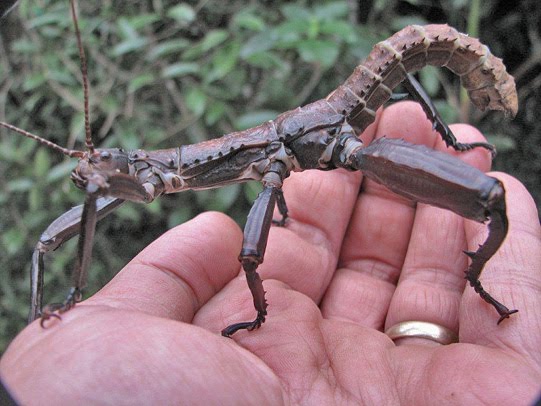A single Melaleuca bush precariously clings to the sharp sheer rock face 225 ft up on Ball’s Pyramid, a spire of remains of the oldest sea stack in the world. This jagged 1844 ft tall steep rock is officially part of Lord Howe Island in the South Pacific Ocean between Australia and New Zealand. Thrashed and battered by constant high winds, this humble plant, related to the renowned tea tree, exists and endures thanks to the choice defecation spot of some perching seabird that deposited a seed primed with fertilizer.
For this location was the only one on the rock where a tiny remnant of its earlier bush-covered glory survived the fell 1918 invasion of shipwrecked Norwegian rats, Rattus norvegicus. Perhaps their impish hands were just too big for the narrow ledges leading to this one bush (though certainly many a rat would’ve leaped to their death trying during the desperate crash phase of their population), or maybe some deserted sailor cat lurks in a crevice nearby, but for whatever reason, this single bush is the last of its kind.
No plant is an island (even on an island) and this plant has traveled through time as a single unitsample of the ecosystem 80 years ago, when bushes of its kind covered Ball’s Pyramid, supporting grazing herds of giant walking sticks, or “tree lobsters” bigger than your hand. Thanks to the investigations by Austalian scientists David Priddel, Nicholas Carlile, and two assistants, who spotted frass (=bug poo) on the plant during a survey climb in 2001, and the subsequent intrepid night climbing by Carlile and ranger Dean Hiscock to find the nocturnal frass-makers, a herd of 24 of the long-thought extinct tree lobster Dryococelus australis were found grazing upon the Melaleuca. These are the heaviest flightless insects in the world.
After the discovery, it took two years to get permission from the Australian government to remove just 4 of the walking sticks to breed in captivity. The first pair died within two weeks in the care of the private breeder assigned the job. The second pair were bred at Melbourne zoo, and the female nearly died after trying to lay eggs but was rescued with a calcium nectar concoction. Now nearly a thousand adults have been reared to adulthood in captivity.
It was noticed that mating pairs of this species exhibited strong bonds for insects, spooning each night.
Conservationists are now considering extirpating the rats on Ball’s Pyramid and repopulating it with captive-bred tree lobsters.
Rats are voracious for most insects and plant seeds. Most likely, they destroyed the native ecosystem in a top down and bottom up blitzkreig of trophic domination. First they went after the seabird eggs and tree lobsters, then smaller insects and seeds of the Melalueca bush. The desperate overpopulated descendents of the first gluttonous rats were driven to eat the toxic Melalueca and destroy and scavenge any organic bits and seeds til the island was scoured clean of plant and insects and soil alike. For though the walking sticks devour the plants, their frassfall and stimulated abscission of tissues by the bush formed the soil essential for water retention around the roots and recycling of nutrients to enriched forms for re-absorption by the plant.
In the age of species extinctions every few seconds, we’ve succeeded in domesticating a nearly extinct species. Farming the tree lobsters will surely become easier over time as they adapt to their streamlined, human-controlled environments. One big question remains: are they really as tasty as lobsters?
Pictures, videos, and news articles:
http://www.arkive.org/lord-howe-island-stick-insect/dryococelus-australis/image-G62716.html

